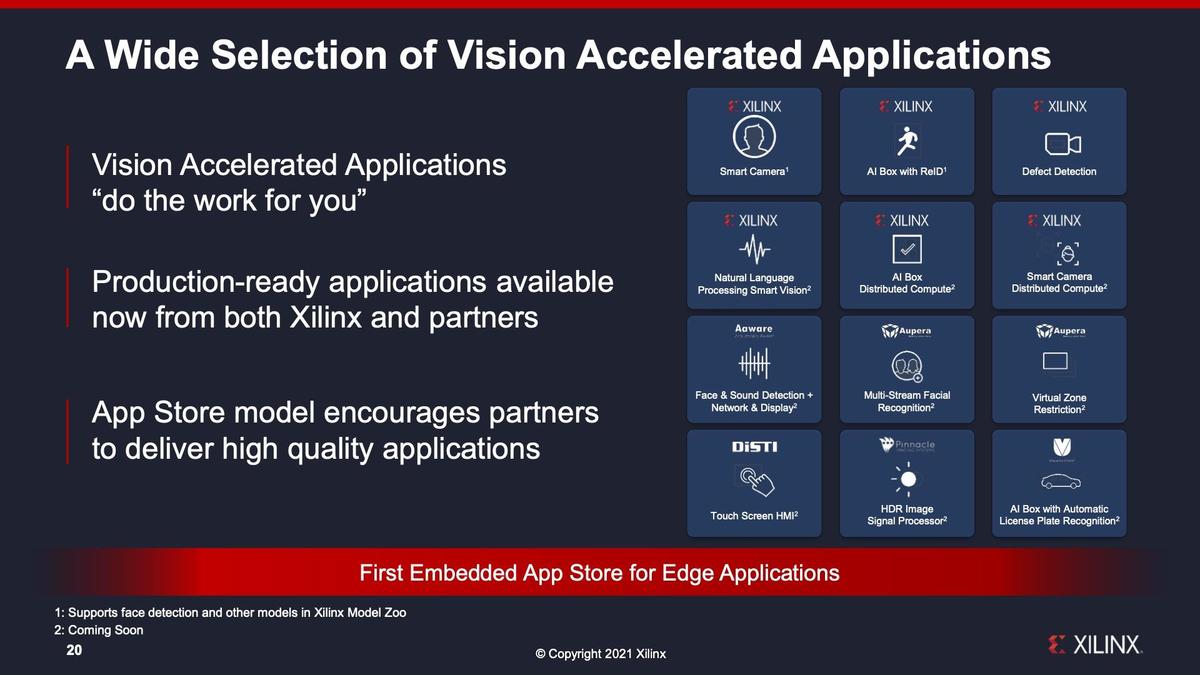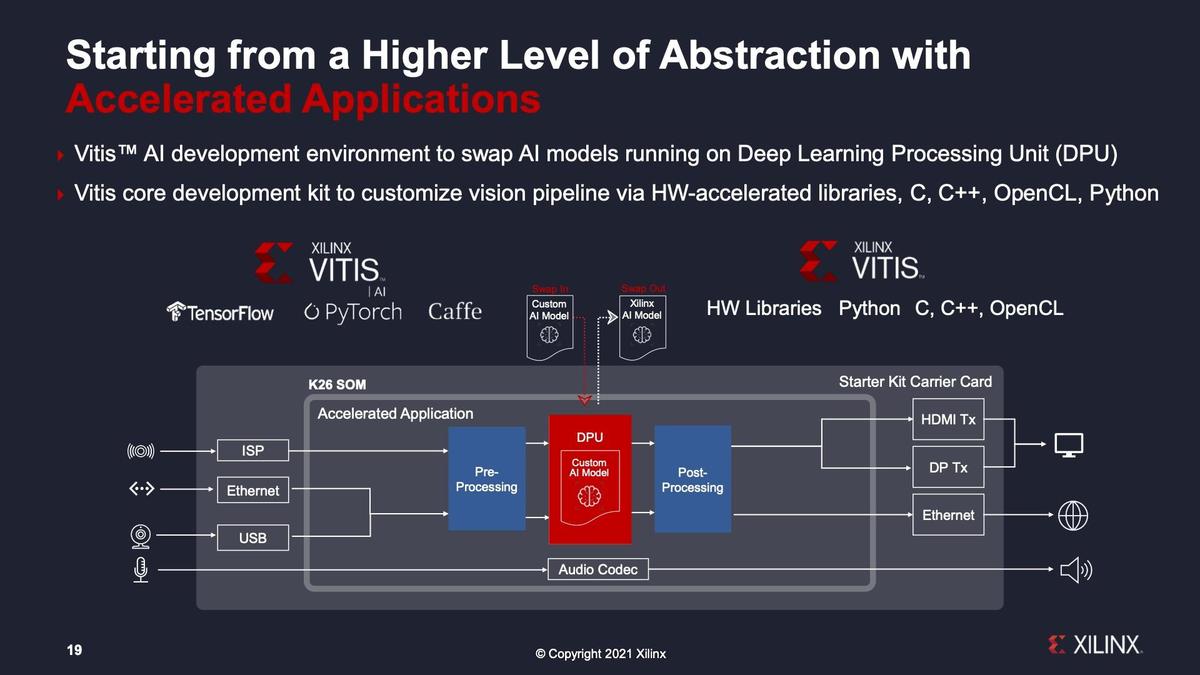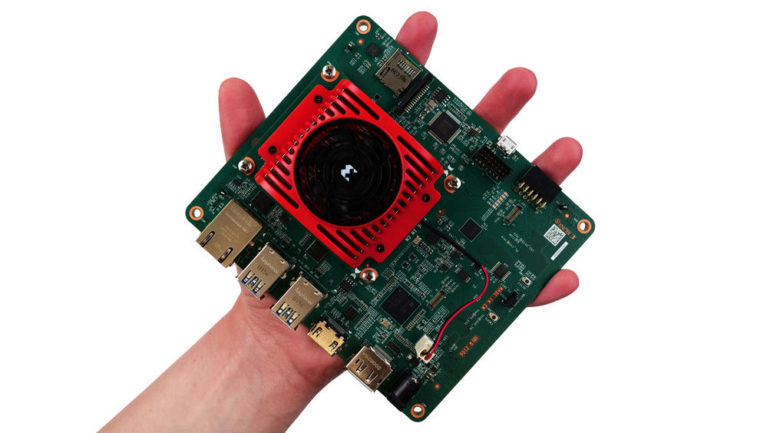The $199 Kria KV260 starter kit comes ready with inputs for mutiple cameras, image processing logic, and softare for object detection, to get people started easily on a computer vision product.
Xilinx
In the hotly contested field of “edge” artificial intelligence, systems and chip makers are coming up with ways to get their customers to market without months or years of machine learning development.
The latest contestant in that regard is programmable-logic maker Xilinx, which on Tuesday unveiled what is planned to be a family of “system-on-module,” or SOM, products, chips on boards with pre-built applications for tasks such as object detection. The announcement features a starter kit for $199 containing all the guts of a camera system to detect people and things in the world.
Kria, as the product line is called, are Xilinx’s first production-ready SOMs. The company is betting that SOMs on the market already from CPU and GPU vendors don’t do a good job for AI, where there is frequent change in the programs that need to be accommodated as machine learning algorithms are refined over time.
“With the existing CPU and GPU-based SOMs on the market, you can’t really balance edge-based computing that operates within power and size constraints, but adapts to the latest [AI] models that are being churned out almost weekly,” said Chetan Khona, who is the director of Xilinx’s Industrial, Vision, Healthcare & Sciences division.
Xilinx is in the process of being acquired by GPU and CPU vendor Advanced Micro Devices.
Kria consists of a Xilinx “Zynq Ultrascale” field programmable gate array, or FPGA, on a small form factor card that includes memory, power management, peripheral interconnects, and other critical support logic, and a companion Kria App Store that features apps that could do the machine learning inference task in uses such as security cameras and machine vision systems for manufacturing.


The Kria App Store features pre-built applciations for basic functions in machine learning such as object detection and facial recognition.
Xilinx
Applications offered on the App Store include face and voice recognition; natural language processing; defect detection, and even highly specific functions such as license-plate recognition.
Kria for the first time accommodates Ubuntu Linux, as an alternative to the PetaLinux the company has provided for years. PetaLinux is designed to a be a modular Linux distribution, with only the parts the developer wants, while Ubuntu is regarded as more of the Cadillac distribution with all the frills.
Performance and efficiency is a big appeal of the FPGA approach, said Khnoa. Xilinx took an existing application for recognizing license plates, designed to run on a GPU, and showed it can run fifty percent faster on Kria, with a third less power.


Developers can go beyond the App Store to use Xilinx’s Vitis development envionrment with whatever TensorFlow or Pytorch code they want.
Xilinx
The practical benefit is the ability to attach more cameras to the Kria SOM versus what you could accommodate with the GPU-based SOM, said Khona.
More important, the Kria line smooths out two challenging areas for developers of Internet of Things and other uses of AI in the field. One is just the labor of programming machine learning. The pre-built apps provide some pre-built code for things such as object detection, but loading a new module, such as face recognition, gives it another capability.
“What these accelerated apps do is, like an app for your smart phone, you drop the app into your SOM and the entire device will take on the personality of the app,” said Khona.
But the product also mean that the customer need have little knowledge of FPGAs, which are a kind of chips that have tended to require special programming expertise that most programmers don’t have unless they’ve spent time working with the technology already.
“You an context switch from doing one thing to doing something else and never have to do any FPGA design.”
Feedback from initial customers, said Khona, was that FPGAs have major benefits for many applications, but that many customers “don’t have the skill set, nor do they even want to learn it.”
“To be honest with ourselves, we said what can we do to attract new customers, to re-imagine how users can engage with Xilinx products.”
The company features the fact that developers can be up and running with Kria in under an hour, “no FPGA experience required.”
Programmers who want more control can use the company’s Vitis programming environment to extend what the apps do, such as, for example by bringing in TensorFlow and Pytorch applications.
The initial Kria module is called the K26, and it comes in two versions. The commercial-grade option can operate in temperatures ranging from zero degrees Celsius (32 degrees Fahrenheit) to 85 degrees Celsius (185 degrees Fahrenheit), and costs $250. A ruggedized version can operate from negative 40 degrees on up to 212 degrees Fahrenheit, for $350. Both versions are available today.
Also: AMD will acquire Xilinx for $35 billion
K26, said Khona, will be followed by a “cost-optimized” version, and a performance-optimized version that gives greater power for things such as real-time computing.
In addition to the K26 module, the company is offering a complete starter kit for computer vision applications, the KV260 Vision AI Starter Kit. The KV260 goes beyond the chip and board to also add hardware interfaces to connect to up to eight cameras, and image signal processing logic. THe KV260 costs $199 and is available today.
Xilinx has had an early-access program, and there are some intriguing uses already up and running. An example application developed with Kria are cameras that could be used in the wildlife parks of South Africa, to watch out for risks to animals such as poachers. That app will pick out what’s an animal versus a person whose movement is captured on camera, and whether the person is an authorized individual, such as a park ranger, or not.
That application was developed by a small South African firm, Kutleng Engineering Systems. Kutleng was able to develop the application in two months from start to finish. The company is competing for a government contract to implement the application.
Also: Flex Logix has two paths to making a lot of money challenging Nvidia in AI
SOMs are expected to be a $2.3 billion market by 2025, said Khona.
It is conceivable the KV260 starter kit could have some of the appeal of D-I-Y kits such as Raspberry Pi, and reach some of the makers who’ve never touched an FPGA. New versions of the starter kit may follow in future with a different focus other than computer vision.
“The makers need to decide for themselves what’s interesting, but we think we’ve done all the right things to peak their interest,” said Khona, when asked if makers will cotton to the kit.
“We’re really trying to make this accessible to small and medium-sized business, and to universities,” said Khona.
There will tutorials and guides online to help newbies to FPGA.
“We make awesome products, but we make complex products, and sometimes you have to ship an applications engineer with our products,” said Khona. “This is really meant to be self-serve, really build out the e-commerce side of our business, and let people engage with the company in a way they never have.”



